Gennaro Gattuso followed in the footsteps of Claudio Ranieri and Cesare Prandelli as the third Italian manager to lead Los Che. He voluntarily resigned from his role at Valencia on January 23.
Just a little time has passed since Gattuso’s dismissal. Still, Valencia’s old reliable Salvador González, better known as Voro, is back in charge as interim manager while the club searches for a permanent replacement.
Voro is the only person who has filled the roles of caretaker, assistant and interim since 2002.
Just after Gattuso left, Voro’s terrible start reached its worst. Voro’s team has now lost three straight games while scoring just one and allowing five goals.
The average age of Valencia’s first team is merely 24.4, making it the youngest in Spain’s premier division. The prospect of a renowned Italian defender becoming a coach and leading the team’s younger players is appealing.
It’s clichéd to say, but things didn’t turn out like they were intended to. It was clear from the start that Gattuso wouldn’t be able to guide Valencia to victory under his watch.
This tactical analysis, written in the style of a scout report, looks at how Valencia’s performances under the subsequent resurgence under Voro after Gattuso differ. This analysis also evaluates how the tactics used by the two managers contributed to Valencia’s slide to the bottom.
Formations and setup
Here you’ll see Valencia’s favoured formations for the current season. The impact of the lately arrived Voro cannot be compared to that of Gattuso in the accompanying figure.
In terms of formation preference, the Italian has shown a clear leaning towards the tried-and-true 4-3-3 (32% of the time).
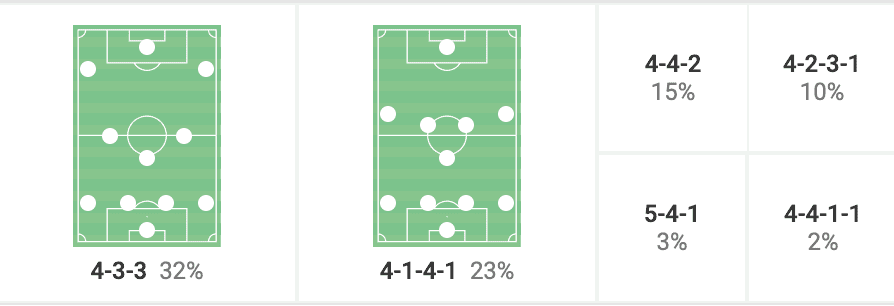
The 4-1-4-1 formation is Gattuso’s second favourite. Both configurations are built around a single resonant pivot. The former Barcelona grads Nico González and Ilaix Moriba paired up with Hugo Guillamón to keep rotating in the lone pivot.
The club has employed the 4-4-1-1 configuration, which has a double-pivot, the least (just 2% of the time). Gattuso’s preferred formation has been a solitary central midfielder surrounded by a plethora of wingers and wide midfielders.
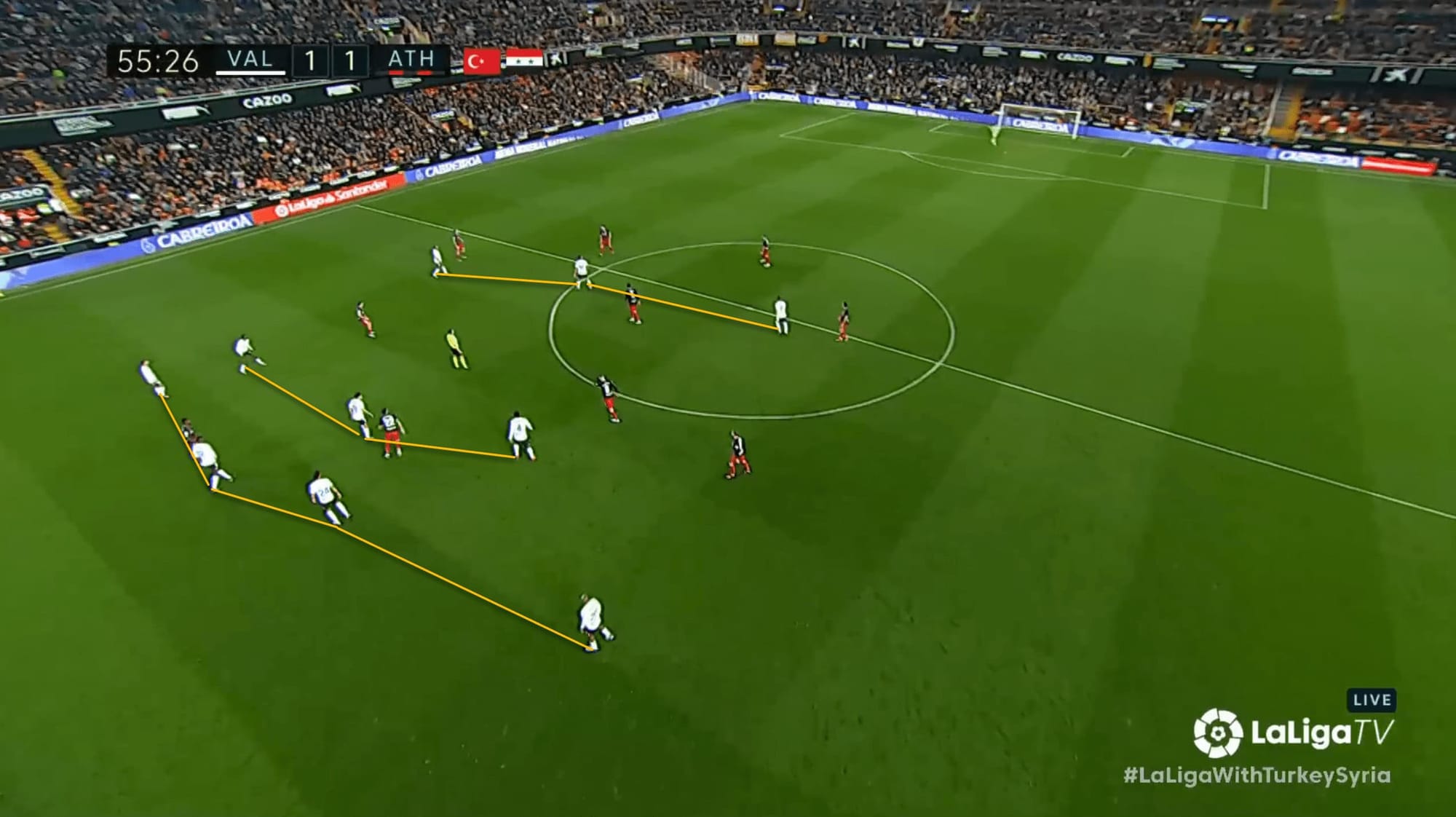
This is a top-down view of Valencia players waiting for a kick from Athletic’s goalie. Under the Italian boss, the team plays in a compact 4-3-3 formation. We’ll now analyse the weaknesses in their approach, focusing on their defence.
Why their pressing doesn’t seem to have much effect
They have allowed 8.49 passes per defensive action, which places them fourth in the PPDA index this season. Their pressing has been at an all-time low.
Neither Los Blancos nor the other Madrid squad has a prayer of competing with Valencia. Of course, Barca’s pressuring has been revitalised and has been superb in it, and they now lead the league with a minimum of 7.45.
Voro’s first league encounter as Valencia’s manager after Gattuso’s dismissal, and it resulted in the worst PPDA in club history. Madrid only allowed 5.97 passes per defensive action, while Los Che totalled 26.56.
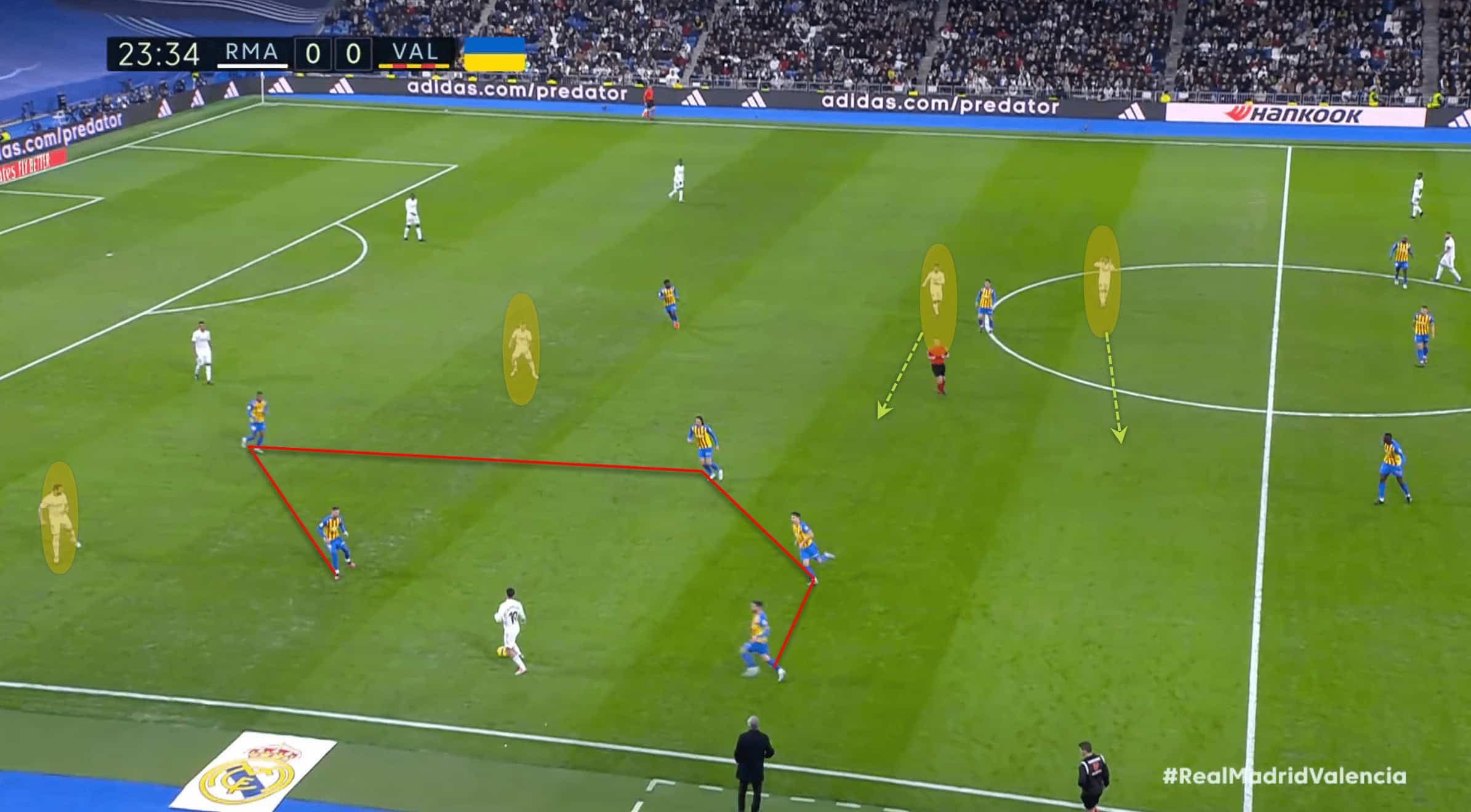
They seemed to be pressing hard, yet there were a lot of cracks in the system. As there are seven Valencians in Madrid’s half but only three in their own, Madrid enjoys a commanding position from which they are mostly unharmed.
The back line seems to be under no pressure, and the attacking midfielders have plenty of space to help out and smash through Valencia’s seven-man structure in a matter of seconds.

But another situation occurred late in the game when ten-man Valencia had trouble keeping up with the typical passing moves of Madrid. All of Carlo Ancelotti’s midfielders are shown above as completely unrestricted and ready to take on any challenge.
It seemed that under Gattuso, Valencia’s defensive vulnerability was worsened by the right back’s instinctive pressing, which allowed Villareal to capitalise on the situation and score two goals.
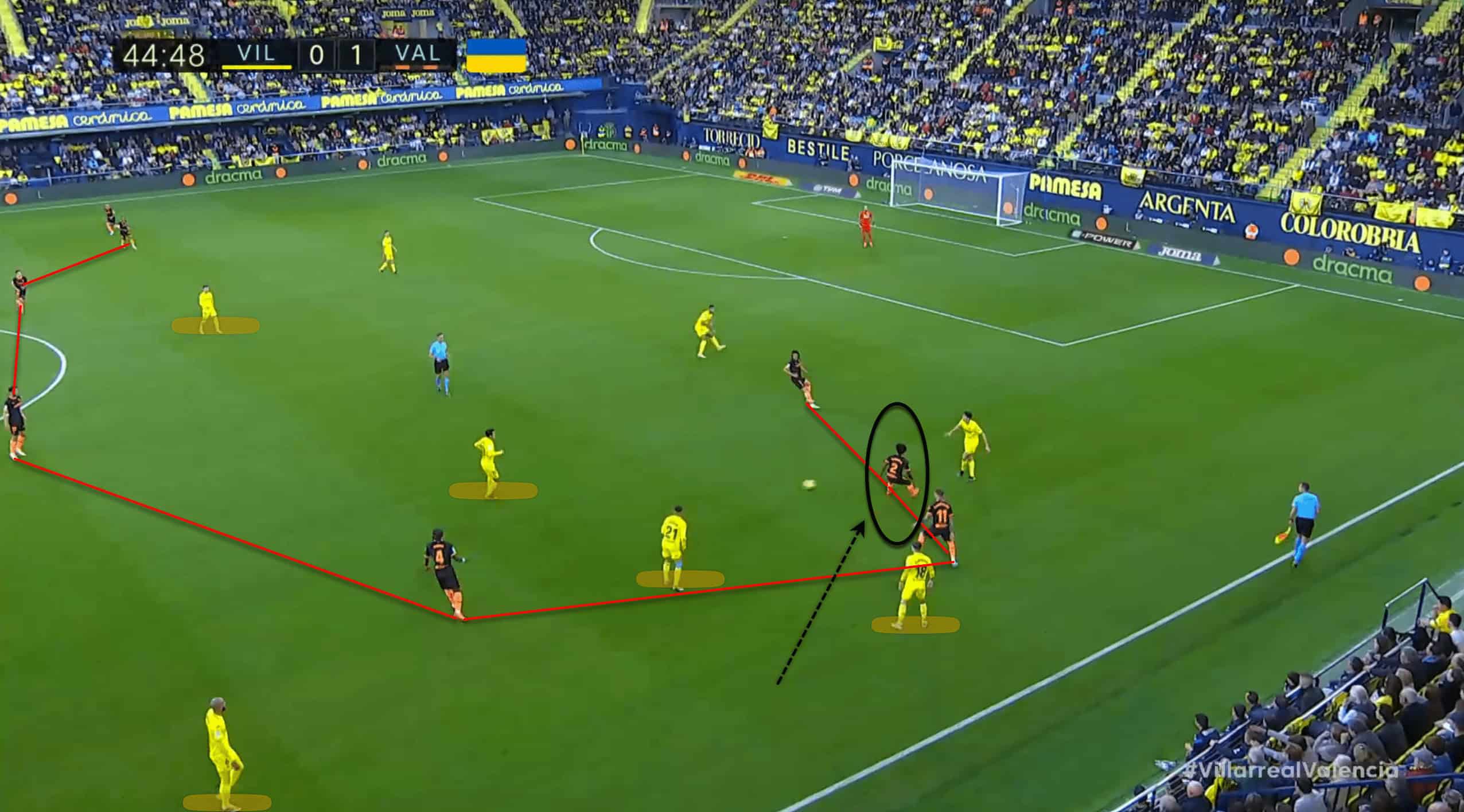
After giving up possession of the ball, the right-back is seen above pressing the defender. Since he was standing on the right, the space to Villarela’s left allowed them to unleash a devastating counterattack.
Even when Gattuso’s Valencia played brilliantly to win in front of their home fans, Cadiz punished them spectacularly.
A single goal scored by Cadiz in the eighth minute was enough to give the visitors a victory on the road. With Los Che’s terrible defeat, Valencia scored their greatest PPDA ever. Valencia barely managed to hold on to 4.67 as Cadiz racked up 13.64.
Defensive arrangement
Valencia always seemed to be on the receiving end of bad luck, whether it was a single player having a particularly awful game full of slips, accidents, and own goals. A terrible shame for Valencia’s devoted following.
Every time the squad let up a goal, no one had any idea until the very last second. Whenever they were behind, it was because of a careless error or a lack of effort on the field, both of which led to a turnover and, subsequently, a goal being conceded.
As can be seen in the next image, Valencia has left enough room on the half-spaces to allow Mallorca to play on it. The defensive line alone is responsible for covering the unmarked players when the midfield line is shattered.
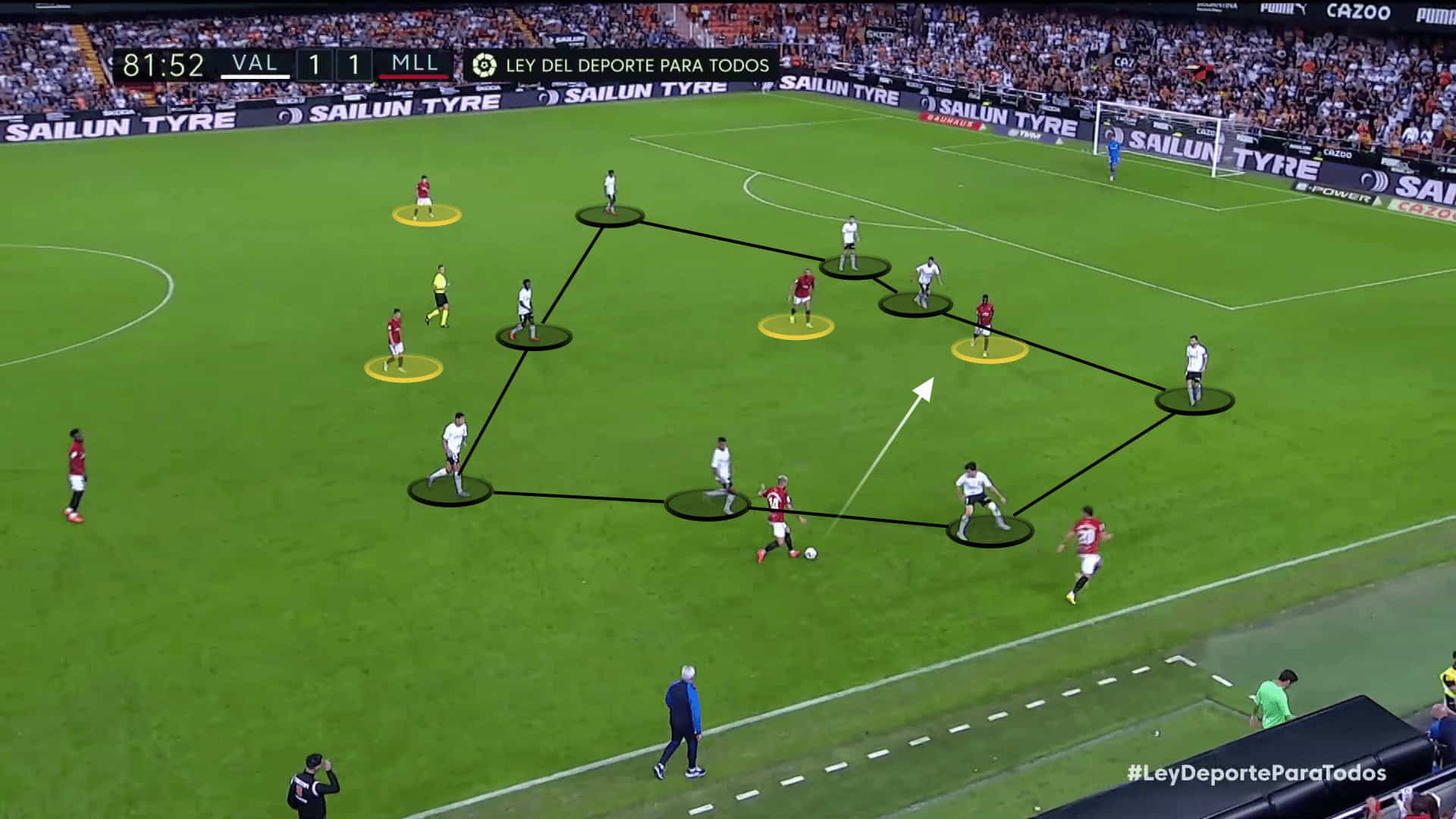
All of Mallorca’s players seem to have plenty of room to make a clean first touch and move the ball around freely. The department has to be restructured to accommodate the shambling structure they’ve come to inhabit.
Under the Italian boss, the back four has completely fallen apart, even though none of the players seemed incompetent or out of control.
A prime suspect is the 23-year-old Portuguese right back, Thierry Correia. Especially impressive to Gattuso would have been his dribbling skills and well-developed physique.
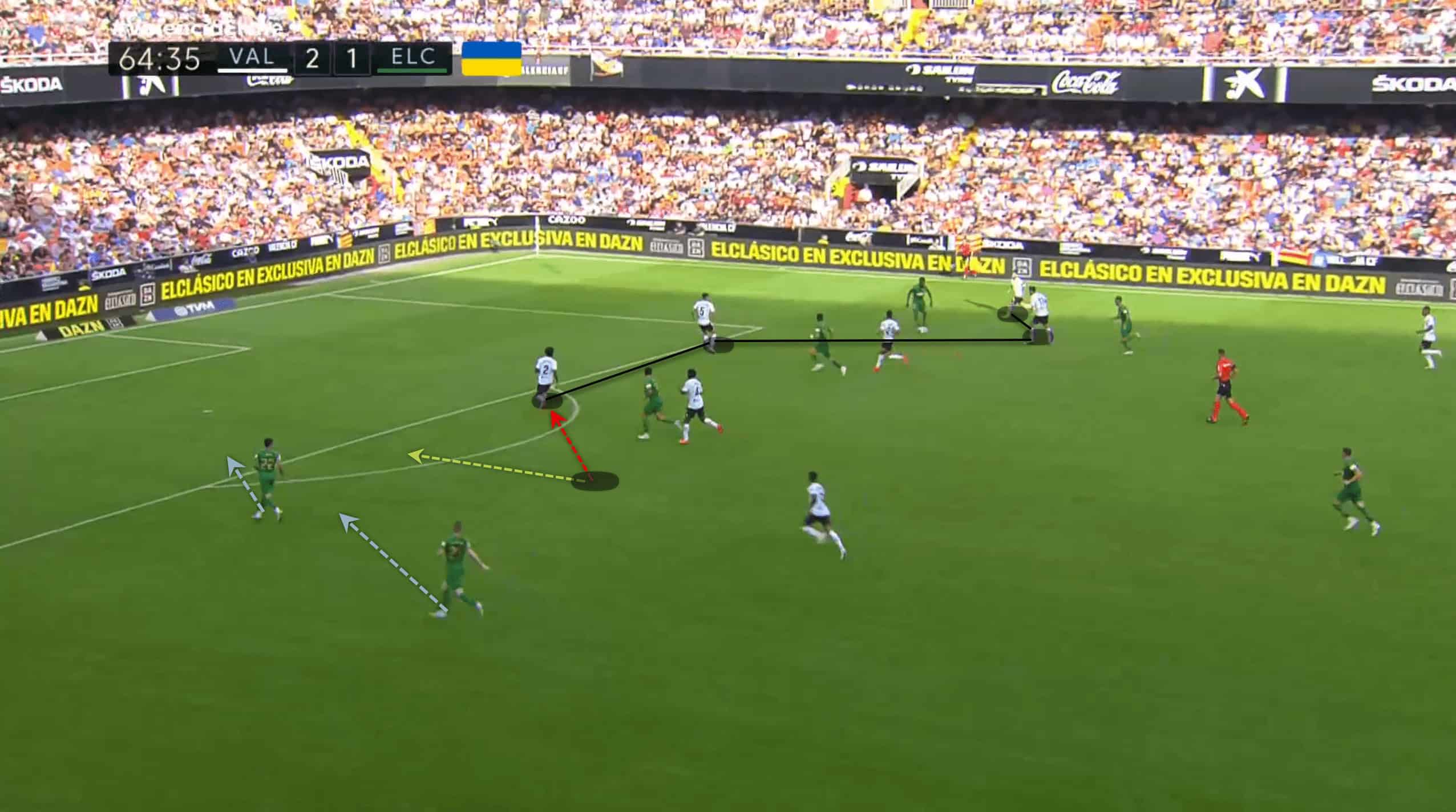
Since Voro’s arrival, the coach has changed his opinion about who should play right back, and Correia hasn’t had any playing time. The defender’s level of alertness is woefully lacking.
Against facing Elche, who are now in bottom place, Valencia’s defence looked as it had never looked before. As Elche had already overloaded the right side of the field, Valencia’s defence was easily breached on the left.
In the above image, Correia’s actual movement is indicated in red, while the possible better move is marked in green.
Knowing that two of Elche’s flank men were charging, Correia made the unfortunate erroneous play that ultimately resulted in Valencia’s deconstruction.
Raphinha, who has been on fire recently, assisted on a goal by Lewandowski with a beautiful cross. The right-back notices the Polish poacher raise his hands in the direction of a cross before Raphinha touches the ball to set it up.
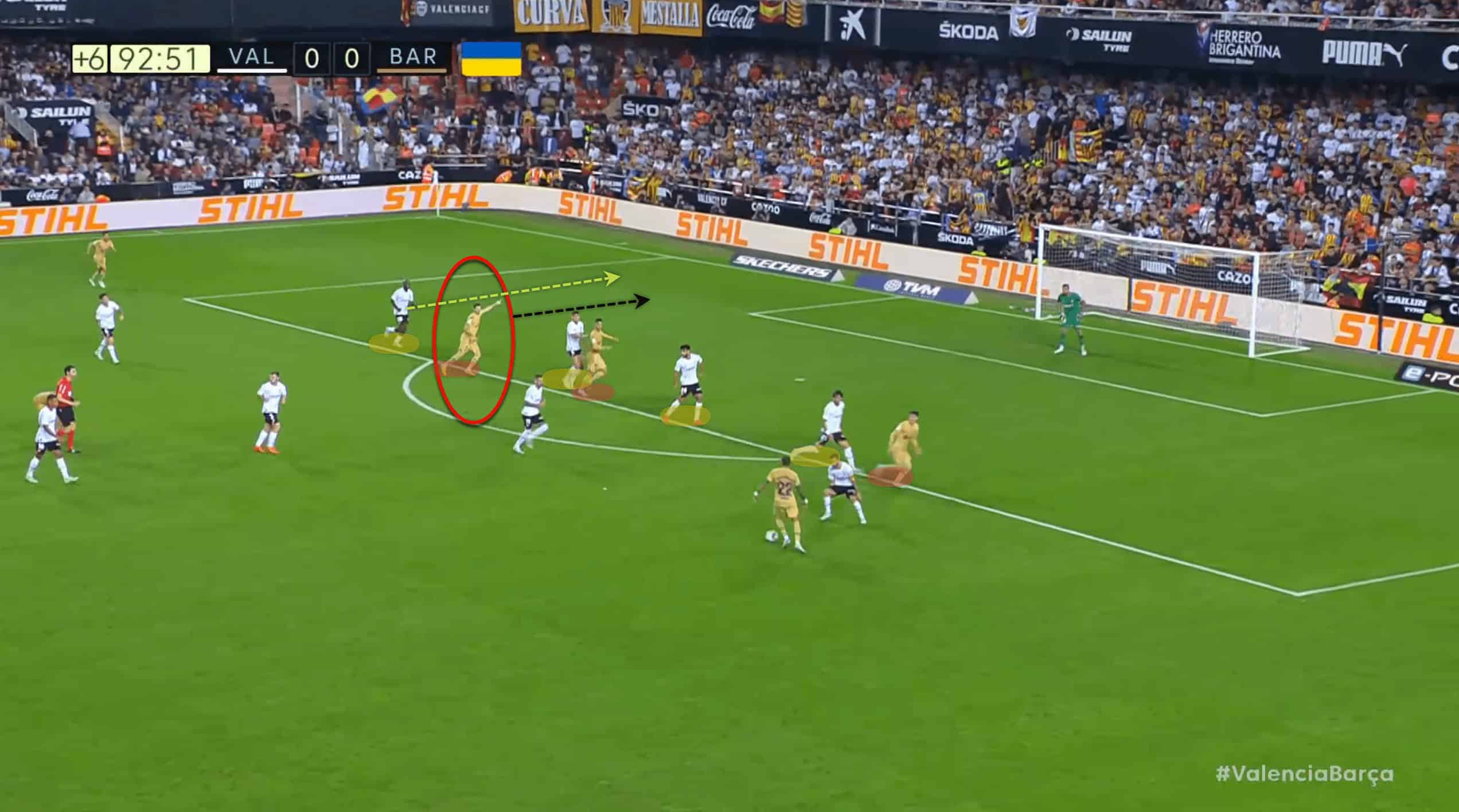
Whenever the Valencian defender spots a free crossing opportunity, he doesn’t drop back to track the striker. In typical Lewandowski fashion, he skillfully snared into the goal.
A series of unfortunate occurrences have rendered the goalie useless, and it makes me think of the attempt by Steve Cooper’s Nottingham Forest to sign PSG goalkeeper Keylor Navas. Such a team to have a top goalkeeper.
Set pieces, in addition to poor defence in general, have been a major factor in this. Valencia has had a lot of trouble defending set pieces, particularly free kicks and corners.
Mamardashvili, the Georgian goalkeeper, is currently in fifth position with 92 shots against him. The space that exists between Valencia’s defence and midfield almost certainly contributes to the number.
Why lack of ferocious attacking mattered
If we look at who has had the most possession of the ball throughout the league so far, it’s hard to go beyond Xavi Hernández and his tiki-taka-styled Barcelona. Quique Setién’s Villareal place just below Los Blancos.
The seasoned left back, Jose Gaya, leads all players on Wyscout with 19 important passes. Gifted players like Ousmane Dembele, Antoine Griezmann, and Vinicius Junior sit in the stands.
Due to Voro’s switch from Gattuso’s 4-3-3 to a 4-4-2, the squad was far less effective against the defending champions. Also, Valencia only passed the ball an average of 2.91 times per possession, which is shocking given how good the team is at keeping the ball.
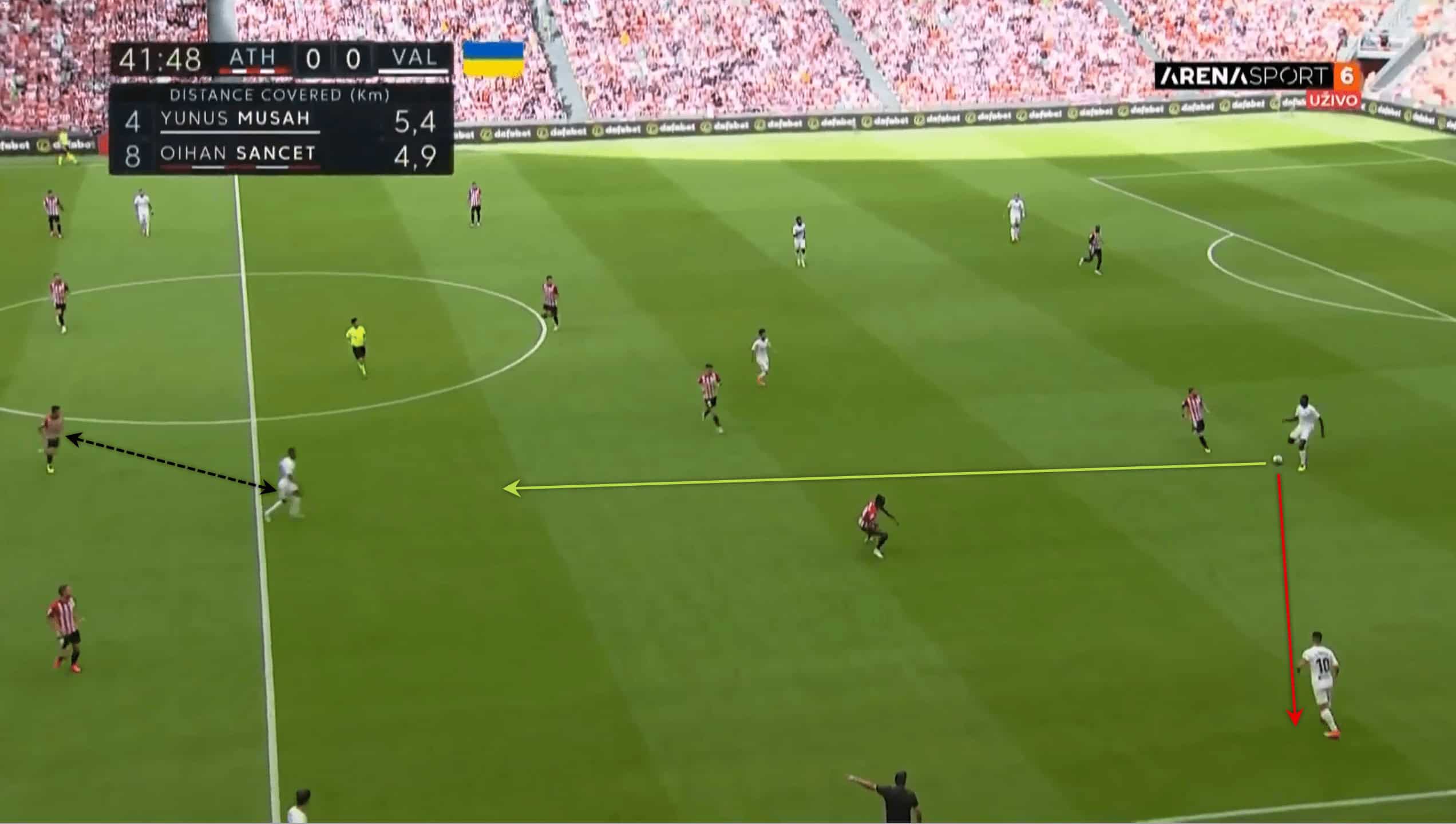
Any commotion in the structure must be cleared away using progressive passes. As shown in the top image, left central defender Mouctar Diakhaby fails to find the open and approaching striker, who has created enough space between himself and his opponent to make a play.
Instead, he passes it to Valencia’s left defender, who is trapped by Athletic’s press and subsequently turns the ball away.
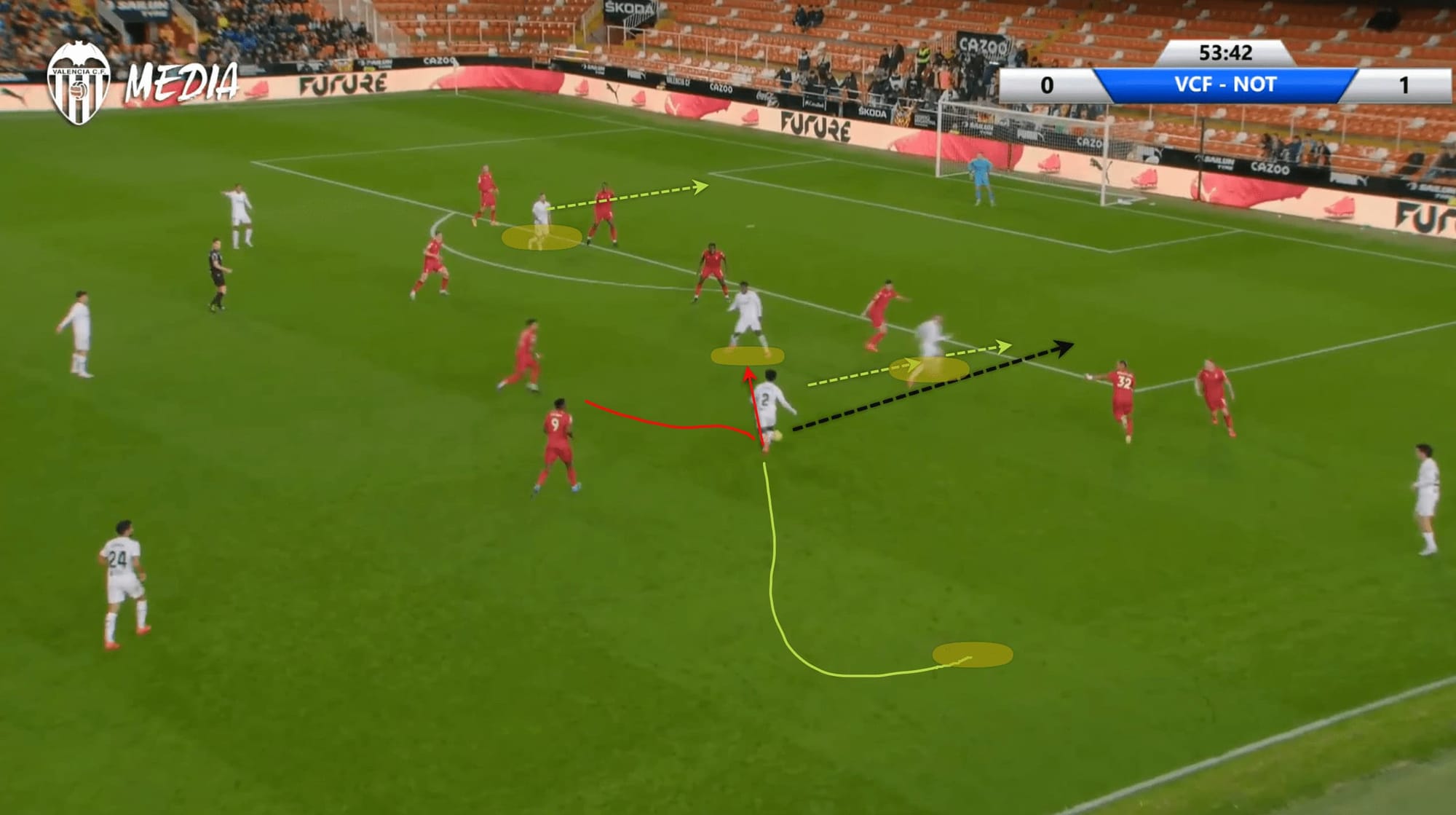
Correia’s cutting insides were useless against Nottingham Forest in a friendly matchup. Even when he spots a runner breaking through the defensive line, he opts for the pass marked in red.
The striker who’s stationed close to his man would move into his poaching scenario if the ball was made to the runner.
While trying to break through the defence or cover more ground on the field has proven to be more effective in the past. However, Girona is dead last in the league despite averaging only 58 passes per game and 1365 in total.
Below, Yunus Musah clears a path through the yellow-outlined length of defences, but no one moves to threaten. Valencia’s structure captured against Sevilla while on the final third is strangely mismatched to what they should be doing.
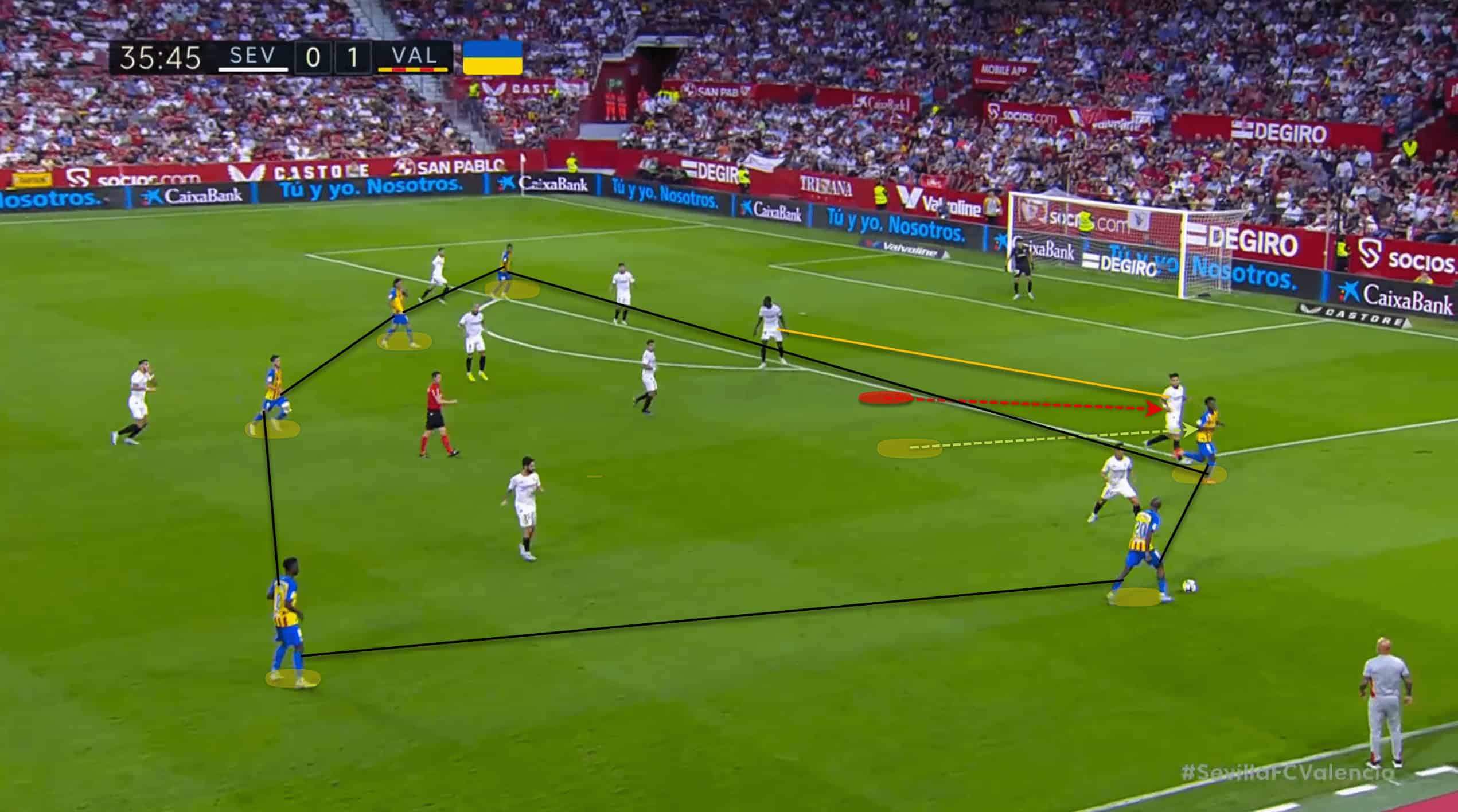
The fact that Sociedad won despite playing with ten men for nearly three-quarters of the game says a lot about Valencia’s inability to capitalise on the situation.
The low block that Sociedad used worked miracles for the home side, who were able to hold off the visitors and preserve a point. Out of 45 attempts, just six of Valencia’s positional assaults resulted in a shot.
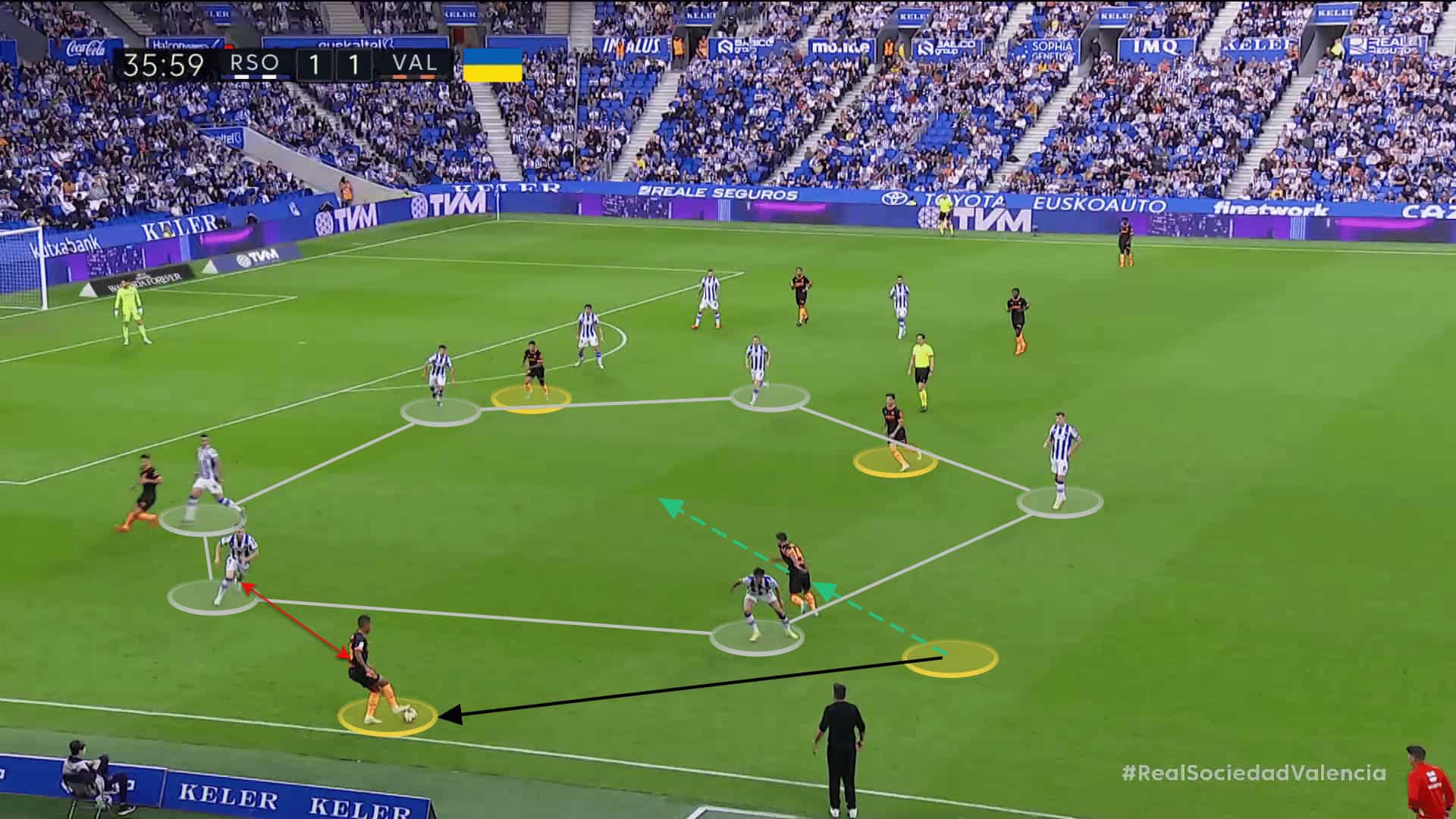
The same thing happened when against Mallorca. Even though Valencia had 67% of the ball and Mallorca had just 33%, Gattuso’s team was unable to score more than once and win the game against Mallorca’s five-man defence at Mestella.
Unfortunately for Valencia, they were unable to get through the three-man central defence due to a lack of combined play in the final third.
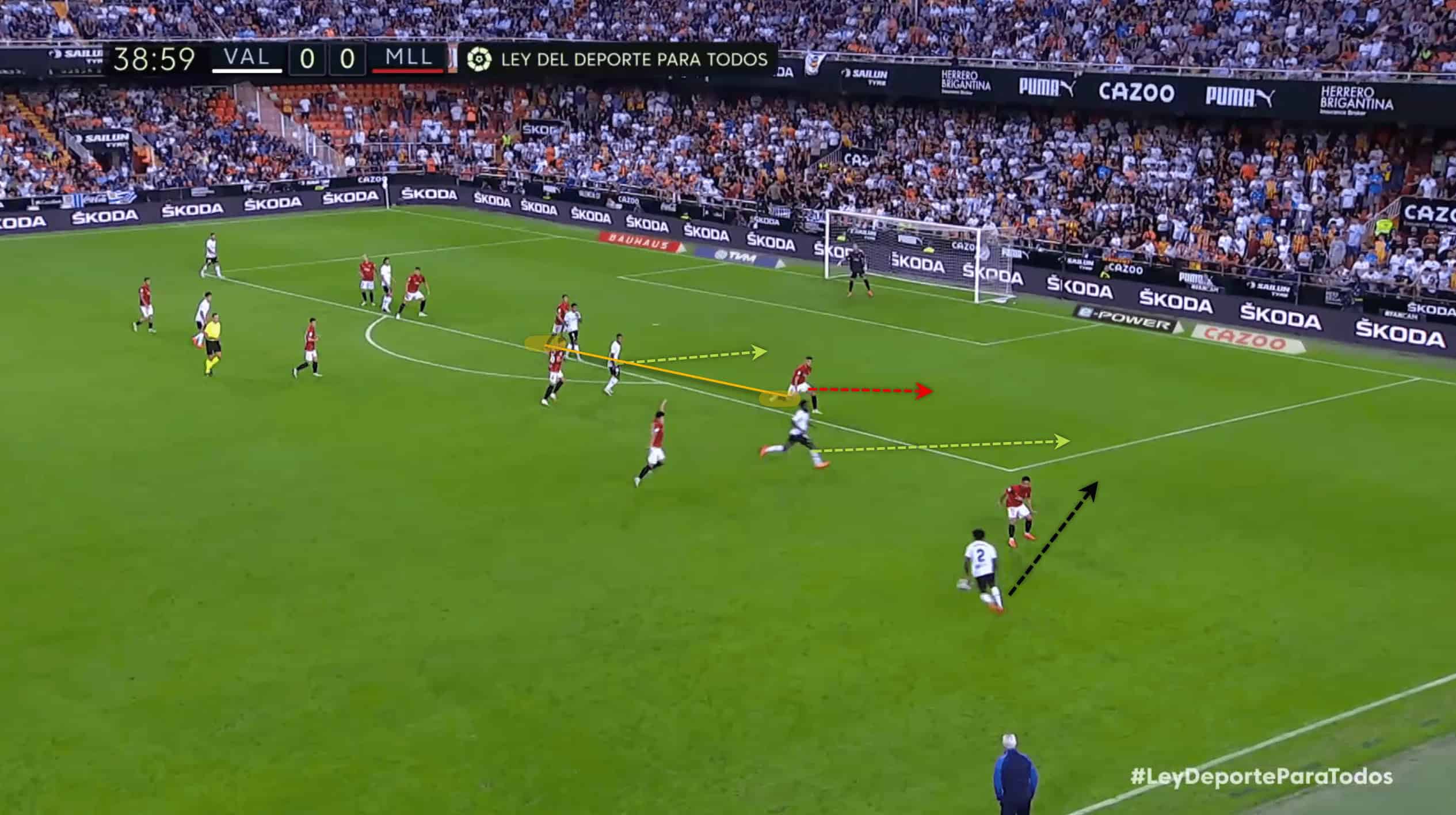
Instead of giving it to the sprinting Musah, Correia takes the direct route in one of the situations. With the defender near him pulled along, Valencia lose the opportunity to threaten a break between the central defenders.
And then Correia would just cross the ball for the sake of it, hoping someone on his team would catch it.
All of your final-third choices should be geared at improving your team’s chances of scoring. Repetition of these situations is necessary for the adjustment required by long-term solutions.
Conclusion
In the current season, Valencia has the fifth-highest total of passes into the final third (1199). In addition, their 76.4% passing accuracy in the final third is third-best in the league.
Edinson Cavani, formerly of PSG, leads Valencia with just five goals whereas the league’s top scorer is Barcelona’s red-hot Robert Lewandowski with 19 goals to his name.
Valencia’s 388 touches inside the opposition’s penalty area rank them seventh amongst the league’s strong hitters.
Surprisingly, Valencia is in second place in the league in through passes (with 179) behind only the leaders and the defending champions. With 248, Barcelona is well ahead of Real Madrid, which is just four goals behind Valencia.
Valencia’s inability to outscore their opponents with their passes raises questions about the reliability of such passes.
With the second-highest rate of through passes, which is the only way to rapidly score a goal, the accuracy has been disastrous. They are in last place in the league with a 26.8% win percentage, behind only Vallecano.
The Brazilian centre defender, Gabriel Paulista, is remarkable with his rate of 6.29 interceptions per 90 minutes, ranking him sixth best in the league.
The 20-year-old American star of the World Cup, Yunus Musah, has been a rock in the middle of the field, allowing his team to create plays and move the ball. Gattuso pinned a lot of his team’s hopes on the kid, just as Leeds United’s Tyler Adams and Weston Mckennie stepped up lately.
With 55.5% of the ball, Valencia sits in fourth place in the league. Also, with this, Valencia has the third-highest total amount of crosses, with 386. Such a feat, especially for a squad on the verge of relegation.
Every team goes through a period of revamping and developing its roster at its own pace. This time, Valencia takes the hit and faces the prospect of influencing the future.
Given the impressive numbers the Valencians have posted, they still have a bright future ahead of them. In order to rebuild, a La Liga team of this magnitude should have access to all the necessary tools.

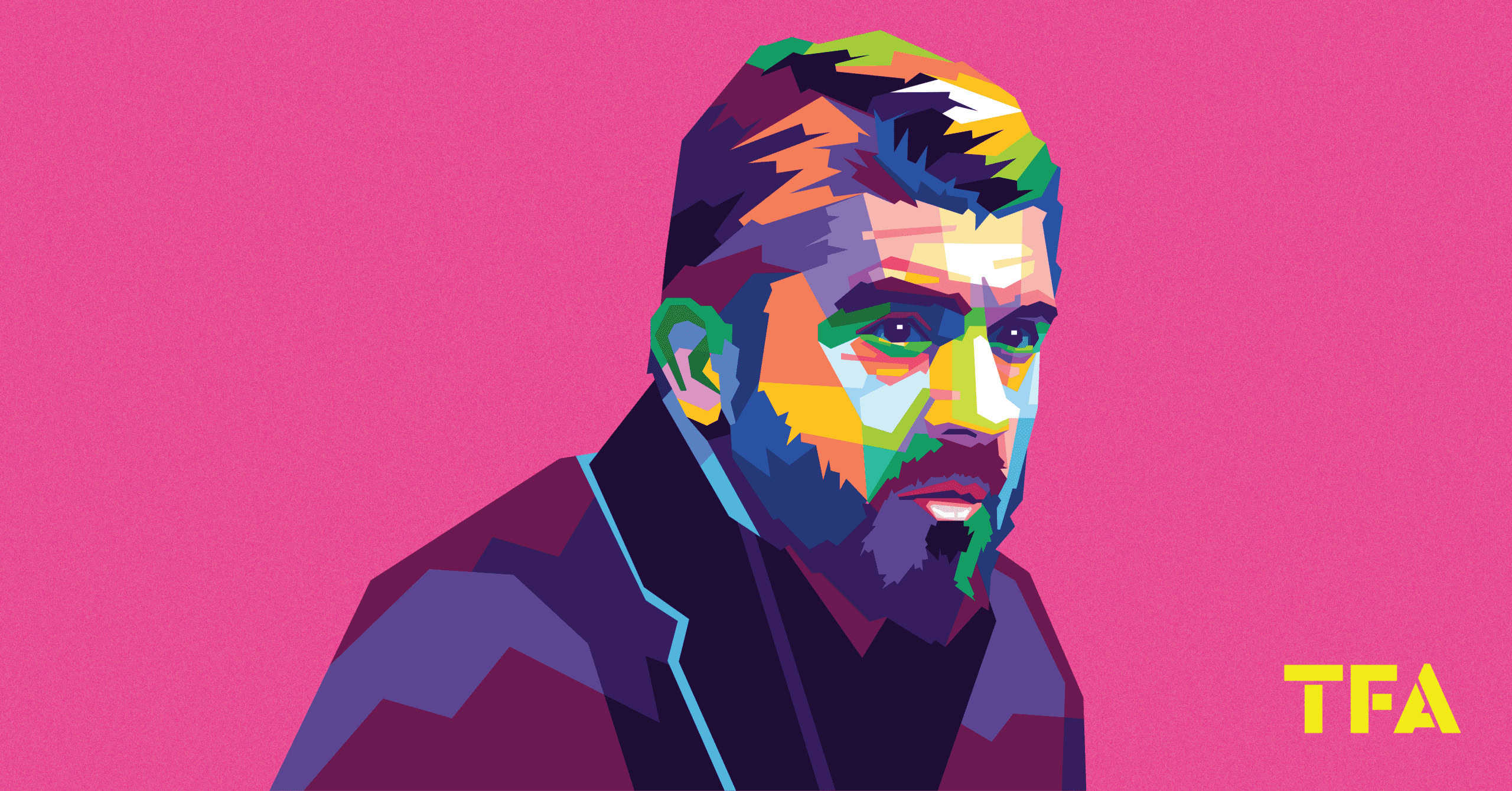



Comments